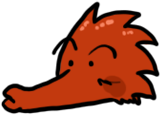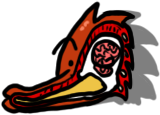Here's a Sega Saturn original!
Mascot platformers you ask? Check out the following reviews!
 VGR: Astal known as Kisuishou Densetsu Astal in Japan
VGR: Astal known as Kisuishou Densetsu Astal in Japan
From Sega
Played on Saturn
Type Platform sidescroller
Originally released as one of the launch titles for the system, Astal can be seen as sort of a technological demo for the Saturn.
With its main objectives being showcasing the prowess of the Sega Saturn as the ultimate 2D video game system.
Yet because 3-D was in its infancy and attracting all the attention, this little gem went unnoticed. Even by most Saturn aficionados.
Still, no reason to ignore Astal and I see it as a rightful and proud iconic character in the pantheon of Sega classic franchises.
Let's dig into the game right away!
Let's dig into the game right away!
What one might notice right away is Astal's fair share of cutscenes and story.
Despite using so very little dialogues, the game packs a lot of content in its plot told via quick scenes either running on the game engine - like classic 16-bit games - as well as some animations.
The game wants itself anime-inspired, and it shows.
The story might seem a bit complex at first, but it's not that complicated.
In another universe, the Goddess Antowas created a world. First she created earth, then the sky and finally air. Before inhabiting this world with life, from a jewel she created its protectors.
From a green jewel a girl, Leda, was born. Leda had the ability to give life to things and create. From a red jewel Antowas made a boy, Astal. His duty was to protect Leda and this new world which became known as
Quartilia.
Antowas soon entered a long awaited sleep.
That is when the evil Jerado appeared, only intending to destroy that world.
Antowas soon entered a long awaited sleep.
That is when the evil Jerado appeared, only intending to destroy that world.
Jerado created a warrior similar to Astal, Geist. And then captured Leda.
But in a twist from the genre, that was not the beginning of the adventure yet. Astal saved the world and Leda prior to the game.
And banished Astal who didn't had the time to explain himself.
Finally Antowas went to her long awaited sleep again.
But now Jerado and Geist are back, better organized and captured Leda again!
As Astal, your goal is to explore this sidescroller, make your way from the banished dimension to the world Quartilia in about sixteen levels and fight several bosses along the way until you get Leda back from Geist. And put a stop to Jerado again. For good this time!
And to do so, Astal has access to several moves unlike most platformers at the time.
Your main attack is done by pressing the B button. Astal can either grab enemies to throw them back again, holding down you can punch the ground or by jumping you can stomp beneath you.
attack B
holding down punch ground up blowing air . defeating enemies fill a
special gauge.
And with the C button Astal can blow air at his foes. The more you defeat enemies the more you fill a special gauge on screen for special moves.
At the end of the first stage Astal will encounter a little bird in a cage who will become Astal's companion though the adventure and the main gimmick of this game!
By either using X Y or Z (or A and rotating options via the L/R triggers) you can send the bird fly away to fetch items back such as health, have the bird perform a special move that is level specific such as lightning the path in the caves, etc. or finally attack enemies on screen. It all depends on the karma level represented by the gauge I mentioned above.
It's a pretty interesting dynamic, once mastered, will allow to progress through the stages seamlessly.
You need to play Astal and use the bird in synch.
That is were the game's other unique approach really shines. You can play Astal via a 2-player mode, simply insert a second controller!
As a co-op game, it adds a whole new approach to the game. The other controlling the bird can interact around easier and it will allow the first player to focus on the platform. It also brings new possible strategies to the bosses.
The game isn't that long, it is about 16-level long but they're actually pretty short. It gets a bit tougher near the middle. The boss fights are actually pretty simple once you get the mechanics down.
The level design falls a bit behind I think. Pretty straightforward. At least each levels has its own unique identity. Like the 2nd stage reminds me of the movie Pitch Black for some reason, with the light going out and flying enemies attack you from the sky.
Graphically that's where the game truly shines.
It's very reminiscent of both Sega's Ristar on the Megadrive and Rayman in both design and gameplay
The game is absolutely gorgeous! Beautiful hand-drawn graphics, great animations and colorful sprites from characters to backgrounds.
The game has a great atmosphere, I love the huge sprites with zoom-ins and outs depending on the situation.
Astal is a very polished game. The action is a bit on the calm side but it's voluntary. Giving Astal a unique approach to platform. It's great to use the bird for special attacks or gathering items.
It's another solid great 2D experience on the system, and worthy of the 32-bit era.
The music was composed by Sega veteran Tatsuyuki Maeda.
The game is also known for its over-the-top voices (both in Japanese and American!). In fact, the NTSC version is at least known for being voiced entirely (all the cast of characters from the entire game!) by Lani Minella, the original Rouge the Bat in the Sonic Adventure 2/Heroes. Though some memorable Japanese sound effects remain on purpose, such as Astal's infamous "Yatta!" screams.
Overall, a fantastic platformer, highly recommended!
Astal holds up pretty well despite its age. It's surprisingly very short (for a 32-bit platformer), the level design is a bit on the simple side but boss fights look great and the graphics are simply amazing.
It's a must try at least once, specially if you like the genre.
Astal ended up selling poorly, even by Saturn standards. I blame an early release (four months before the Saturn itself was actually released!!). With barely any marketing, even Sega-fans who would end up buying the Saturn at some point probably left it aside/ignored Astal for the flashier Virtua Fighter, Panzer Dragoon and other Daytona USA....
Not only was Astal ignored by everyone, but the gritty NTSC box art and the fact it didn't even got a Pal release probably didn't help neither...
This would be the first and only game starring Astal. And unlike other contemporary Saturn exclusives such as BUG! and Clockwork Knight, Astal would never even get the chance to redeem himself in a sequel on the same system. And while other obscure cult Sega characters often get cameos or have since made comebacks as playable characters in racing or trennis crossover games, Astal was just forgotten over the years (despite a quick cameo in the opening video of Segagaga on the Dreamcast).
Astal holds up pretty well despite its age. It's surprisingly very short (for a 32-bit platformer), the level design is a bit on the simple side but boss fights look great and the graphics are simply amazing.
It's a must try at least once, specially if you like the genre.
Astal ended up selling poorly, even by Saturn standards. I blame an early release (four months before the Saturn itself was actually released!!). With barely any marketing, even Sega-fans who would end up buying the Saturn at some point probably left it aside/ignored Astal for the flashier Virtua Fighter, Panzer Dragoon and other Daytona USA....
Not only was Astal ignored by everyone, but the gritty NTSC box art and the fact it didn't even got a Pal release probably didn't help neither...
This would be the first and only game starring Astal. And unlike other contemporary Saturn exclusives such as BUG! and Clockwork Knight, Astal would never even get the chance to redeem himself in a sequel on the same system. And while other obscure cult Sega characters often get cameos or have since made comebacks as playable characters in racing or trennis crossover games, Astal was just forgotten over the years (despite a quick cameo in the opening video of Segagaga on the Dreamcast).
I give it:












No comments:
Post a Comment